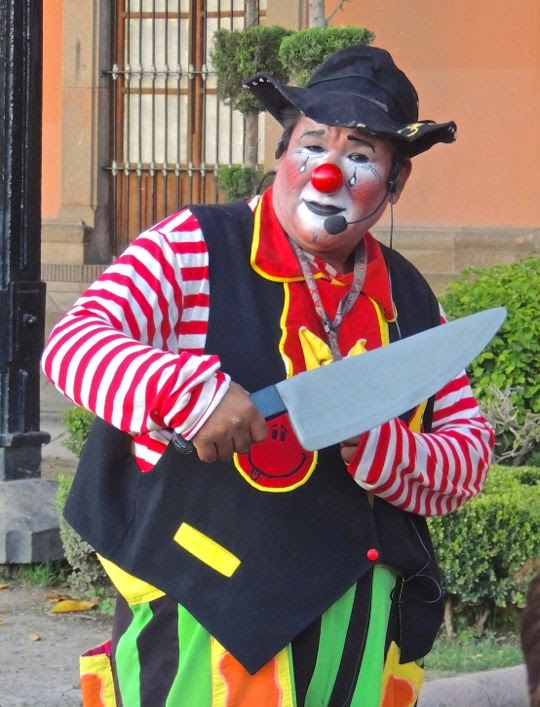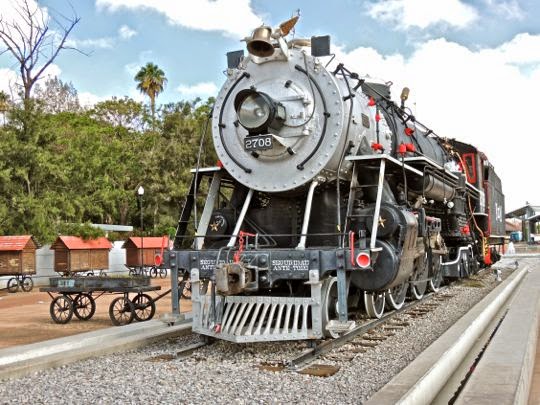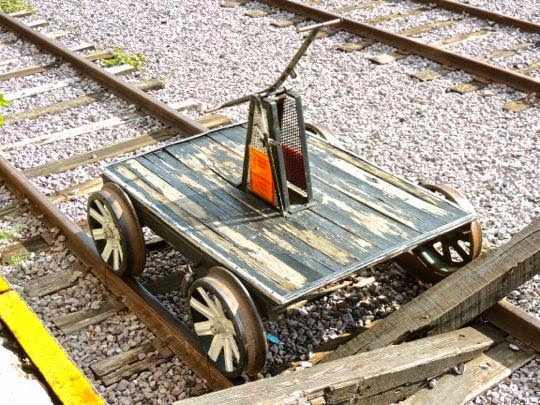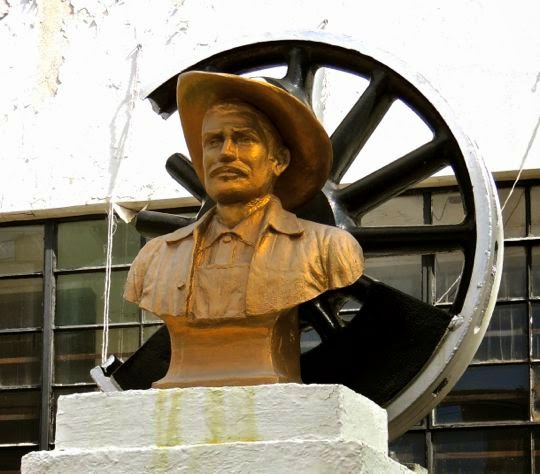Traversing the Rio Caliente, one of many crossings we made that day. A few months ago, I joined a group of other hikers to visit the Rio Caliente area of the Bosque de la Primavera (Forest of the Spring), a huge natural preserve next to Guadalajara. I have visited various sections of the Bosque over the years and each visit has been unique. The areas have been so different from one another that I could almost believe that I was in a different part of the state each time. One reason for this is the size of the Bosque de la Primavera. At 30,500 hectares (75,367 acres), it nearly equals huge, sprawling Guadalajara itself. For a Google map showing the forest and its cheek-by-jowl relationship with the city, click here.
Our hiking group was almost as varied as the different parts of the Bosque. Our international set of hikers totalled eleven: six from the US, four Canadians, and one Brit. Although Abela, seen above in the lead, is Canadian, I believe she is a Filipina who immigrated. The group included nine men and two women, all experienced hikers. In addition to the human contingent, I should also mention that two of our most enthusiastic hikers were dogs: Levi and Matty.
Levi never misses a hike if Larry, his dog-dad, comes along. Possessing one of the most beautiful coats I have ever seen on a collie, Levi wins the admiration of everyone he encounters. He is still a young dog, but that gives him the energy to cover several times the ground that human hikers do on the same trek. As you can see, the hike took place in early spring, a very dry season when much of the vegetation is rusty brown in color. Except for the evergreens, only those plants close to water sources show any green.
Small concrete dams create shallow pools at various points along the river. The spillway along the left bank has resulted in a waterfall. The Rio Caliente runs through a winding valley with steep bluffs on either side. The bluffs rise to a broad rolling plateau. The Bosque de la Primavera is roughly oval in shape. It is essentially a huge, heavily-forested and steep-sided plateau made up of ancient lava. The top area is covered with ridges and volcanic craters and these, in turn, are blanketed with forests of oak and pine. These forests have been described as "the lungs of Guadalajara." Water has cut through the soft tufa soil, creating deep, sheer-sided ravines with streams along the bottoms. In some areas, residual vulcanism has resulted in hot springs. It is from these sources of boiling water that Rio Caliente (Hot River) gets its name. For a satellite view of the river area, click here.
Eileen leaps across the top of a waterfall while Abela waits her turn. With her long legs, the jump is a piece of cake for Eileen. Not so much for petite Abela. While the river is nowhere very deep, care must be taken to avoid a twisted ankle or worse. A sturdy hiking stick like that carried by Abela can provide a vital third point of balance.
After leaping the waterfall, we proceed up a deep arroyo. Gary (left) Chuck (center) and Paul (right) move through dry grass and light undergrowth as they pick their way along a faint path. The green undergrowth in the center-right of the photo tracks a stream of hot water originating further up the arroyo. The Bosque is a rather odd amalgam of federal and state jurisdictions, with a patchwork of private ownership mixed into it. There were attempts back in the 1960s and 70s to open it to large-scale real estate development, but fortunately these were resisted.
A hot waterfall tumbled down from above. The further up the arroyo we moved, the hotter the water. Fortunately, the morning was still cool so the experience was quite pleasant.
The deeper we got into the arroyo, the more steeply the sides rose on either side. If you look closely, you can see a bit of steam rising from the rushing water. The cliffs toward the end of the cut rose at least a couple of hundred feet above us.
Jim B takes a break beside a hot pool. He looked to me like a big leprechaun wielding an over-sized magic wand. Jim has become the de facto leader of the hikers that set out from Donas Donuts in Ajijic every Tuesday and Friday morning. Each month, he emails out a list of proposed hikes. While many of these are very challenging even for the more experienced folks, he often suggests alternate routes for those with more leisurely inclinations. Challenging or not, Jim's hikes are always interesting and often spectacular.
Lush vegetation grows on the creek bottom, encouraged by the hot, mineral-rich water. Long filmy tendrils of emerald-green plants wave in the swift current. At this point, the water is hot to the touch.
Steam rises from the stream bed as we near the source of the boiling water. I wouldn't care to stick my bare foot into this water. Here, the trail turned up the hill, so we never encountered the spring where the hot water emerges from the head of the arroyo. Perhaps next time.
Abela takes a breather. The trail becomes quite steep at this point. Huge leaves from the surrounding oak forest filled the depression of the trail bed. We had to step carefully to avoid tripping over large, hidden rocks. In the background, you can see the sheer cliffs surrounding the head of the arroyo.
Up, up, and more up. The surrounding oak trees were sparse enough that we could see our goal: the top of the ridge. I have always found that a stiff climb is easier if I can see the end of it, and thus measure my progress.
Jacques perches on a handy boulder beside the trail. Jacques, a Canadian, is a "snow bird" who comes down every winter. He returned to the still-snowy north shortly after this hike. One of the stronger and more adventurous hikers among us, Jacque is always ready to pioneer a new route.
The top of the plateau is covered with an open pine forest. Having reached the top, we found a deep layer of large, rust-hued, pine needles underfoot. Having walked over many a rocky trail, they formed a pleasant cushion beneath my boots. There is very little undergrowth on the plateau and the trees are widely spaced. This provides the feel of a manicured park. For those used to the thick, jungly trails in the mountains overlooking Lake Chapala, the broad vistas and open feel of this forest comes as a pleasant surprise.
We paused at the edge of the plateau to view the Rio Caliente far below. At this point, we are about 150 m (492 ft) above the canyon bottom. Our route will take us back down the face of the bluff to the left side of the river bank, then across to the right bank and back along the trail visible near the center of the photo.
Hikers string out along the left bank of the river. We made a rather precarious descent down a trail worn into a mini-ravine by water rushing off the plateau. Upon reaching the bottom, we found the stream-side area to be comfortably flat and sandy.
All good things come to an end, as did the left bank's easy hiking. Once again we had to cross the river. Above, Garry "boulder hops" across. One has to be particularly careful in these manoeuvres because a solid-looking rock may have been undercut by the water and now be precariously balanced. Another use for a good hiking stick is to test such rocks for movement.
Abela makes a leap of faith. With her shot legs, this was really a stretch. Several people had taken this route before her, so she was reasonably sure that the rock she was aiming for wasn't wobbly. To the right, her husband Geoff watches her jump. In the background, Jim B surveys the progress of the group.
Paul, our British hiker, takes a break for a snack. Everyone made it across the river without incident, so we settled down for some water and snacks. This point was as far as we ventured along the river. From here we headed back to our cars. Our real destination, however, was the hot pool not far from where we had parked.
A rough stone stairway leads down from the parking area. Abela and Matty the dog lead the way as hikers hurry down for a long, relaxing soak. The hot pool was created by another of the small dams along the river.
Chuck soaks tired muscles while Matty, his dog, looks on skeptically. Matty is ordinarily an enthusiastic water dog. For some reason she seemed a bit leery of this strange hot liquid. Not so with Chuck, who took full advantage of the soothing heat.
Paul swims in the center of the pool. The pool is broad enough, and the water deep enough, that you can paddle around a bit if you are feeling ambitious at all. Most people's ambition seemed to evaporate as soon as they hit the water.
Geoff and Abela enjoy a chuckle. Parts of the pool have natural backrests and these two were taking full advantage. The bottom of the pool is mostly sand and small pebbles, although you need to be careful of the occasional large rock.
Jim C kicks back on a man-made bench at the edge of the water. Unfortunately, the bench was a bit marred by the graffiti so often present in areas close to a road. I had neglected to bring a bathing suit, so I contented myself with wading about, soaking my feet, and taking photos of everyone else. Finally, someone insisted that I should become part of the photo story too, and took this shot of me.
This completes my posting on the Rio Caliente hike. I hope you have enjoyed it and, if so, please leave any thoughts or questions in the Comments section or email me directly.
If you leave a question in the Comments section, PLEASE leave your email address so I can respond.
Hasta luego, Jim
Our hiking group was almost as varied as the different parts of the Bosque. Our international set of hikers totalled eleven: six from the US, four Canadians, and one Brit. Although Abela, seen above in the lead, is Canadian, I believe she is a Filipina who immigrated. The group included nine men and two women, all experienced hikers. In addition to the human contingent, I should also mention that two of our most enthusiastic hikers were dogs: Levi and Matty.
Levi never misses a hike if Larry, his dog-dad, comes along. Possessing one of the most beautiful coats I have ever seen on a collie, Levi wins the admiration of everyone he encounters. He is still a young dog, but that gives him the energy to cover several times the ground that human hikers do on the same trek. As you can see, the hike took place in early spring, a very dry season when much of the vegetation is rusty brown in color. Except for the evergreens, only those plants close to water sources show any green.
Small concrete dams create shallow pools at various points along the river. The spillway along the left bank has resulted in a waterfall. The Rio Caliente runs through a winding valley with steep bluffs on either side. The bluffs rise to a broad rolling plateau. The Bosque de la Primavera is roughly oval in shape. It is essentially a huge, heavily-forested and steep-sided plateau made up of ancient lava. The top area is covered with ridges and volcanic craters and these, in turn, are blanketed with forests of oak and pine. These forests have been described as "the lungs of Guadalajara." Water has cut through the soft tufa soil, creating deep, sheer-sided ravines with streams along the bottoms. In some areas, residual vulcanism has resulted in hot springs. It is from these sources of boiling water that Rio Caliente (Hot River) gets its name. For a satellite view of the river area, click here.
Eileen leaps across the top of a waterfall while Abela waits her turn. With her long legs, the jump is a piece of cake for Eileen. Not so much for petite Abela. While the river is nowhere very deep, care must be taken to avoid a twisted ankle or worse. A sturdy hiking stick like that carried by Abela can provide a vital third point of balance.
After leaping the waterfall, we proceed up a deep arroyo. Gary (left) Chuck (center) and Paul (right) move through dry grass and light undergrowth as they pick their way along a faint path. The green undergrowth in the center-right of the photo tracks a stream of hot water originating further up the arroyo. The Bosque is a rather odd amalgam of federal and state jurisdictions, with a patchwork of private ownership mixed into it. There were attempts back in the 1960s and 70s to open it to large-scale real estate development, but fortunately these were resisted.
A hot waterfall tumbled down from above. The further up the arroyo we moved, the hotter the water. Fortunately, the morning was still cool so the experience was quite pleasant.
The deeper we got into the arroyo, the more steeply the sides rose on either side. If you look closely, you can see a bit of steam rising from the rushing water. The cliffs toward the end of the cut rose at least a couple of hundred feet above us.
Jim B takes a break beside a hot pool. He looked to me like a big leprechaun wielding an over-sized magic wand. Jim has become the de facto leader of the hikers that set out from Donas Donuts in Ajijic every Tuesday and Friday morning. Each month, he emails out a list of proposed hikes. While many of these are very challenging even for the more experienced folks, he often suggests alternate routes for those with more leisurely inclinations. Challenging or not, Jim's hikes are always interesting and often spectacular.
Lush vegetation grows on the creek bottom, encouraged by the hot, mineral-rich water. Long filmy tendrils of emerald-green plants wave in the swift current. At this point, the water is hot to the touch.
Steam rises from the stream bed as we near the source of the boiling water. I wouldn't care to stick my bare foot into this water. Here, the trail turned up the hill, so we never encountered the spring where the hot water emerges from the head of the arroyo. Perhaps next time.
Abela takes a breather. The trail becomes quite steep at this point. Huge leaves from the surrounding oak forest filled the depression of the trail bed. We had to step carefully to avoid tripping over large, hidden rocks. In the background, you can see the sheer cliffs surrounding the head of the arroyo.
Up, up, and more up. The surrounding oak trees were sparse enough that we could see our goal: the top of the ridge. I have always found that a stiff climb is easier if I can see the end of it, and thus measure my progress.
Jacques perches on a handy boulder beside the trail. Jacques, a Canadian, is a "snow bird" who comes down every winter. He returned to the still-snowy north shortly after this hike. One of the stronger and more adventurous hikers among us, Jacque is always ready to pioneer a new route.
The top of the plateau is covered with an open pine forest. Having reached the top, we found a deep layer of large, rust-hued, pine needles underfoot. Having walked over many a rocky trail, they formed a pleasant cushion beneath my boots. There is very little undergrowth on the plateau and the trees are widely spaced. This provides the feel of a manicured park. For those used to the thick, jungly trails in the mountains overlooking Lake Chapala, the broad vistas and open feel of this forest comes as a pleasant surprise.
We paused at the edge of the plateau to view the Rio Caliente far below. At this point, we are about 150 m (492 ft) above the canyon bottom. Our route will take us back down the face of the bluff to the left side of the river bank, then across to the right bank and back along the trail visible near the center of the photo.
Hikers string out along the left bank of the river. We made a rather precarious descent down a trail worn into a mini-ravine by water rushing off the plateau. Upon reaching the bottom, we found the stream-side area to be comfortably flat and sandy.
All good things come to an end, as did the left bank's easy hiking. Once again we had to cross the river. Above, Garry "boulder hops" across. One has to be particularly careful in these manoeuvres because a solid-looking rock may have been undercut by the water and now be precariously balanced. Another use for a good hiking stick is to test such rocks for movement.
Abela makes a leap of faith. With her shot legs, this was really a stretch. Several people had taken this route before her, so she was reasonably sure that the rock she was aiming for wasn't wobbly. To the right, her husband Geoff watches her jump. In the background, Jim B surveys the progress of the group.
Paul, our British hiker, takes a break for a snack. Everyone made it across the river without incident, so we settled down for some water and snacks. This point was as far as we ventured along the river. From here we headed back to our cars. Our real destination, however, was the hot pool not far from where we had parked.
A rough stone stairway leads down from the parking area. Abela and Matty the dog lead the way as hikers hurry down for a long, relaxing soak. The hot pool was created by another of the small dams along the river.
Chuck soaks tired muscles while Matty, his dog, looks on skeptically. Matty is ordinarily an enthusiastic water dog. For some reason she seemed a bit leery of this strange hot liquid. Not so with Chuck, who took full advantage of the soothing heat.
Paul swims in the center of the pool. The pool is broad enough, and the water deep enough, that you can paddle around a bit if you are feeling ambitious at all. Most people's ambition seemed to evaporate as soon as they hit the water.
Geoff and Abela enjoy a chuckle. Parts of the pool have natural backrests and these two were taking full advantage. The bottom of the pool is mostly sand and small pebbles, although you need to be careful of the occasional large rock.
Jim C kicks back on a man-made bench at the edge of the water. Unfortunately, the bench was a bit marred by the graffiti so often present in areas close to a road. I had neglected to bring a bathing suit, so I contented myself with wading about, soaking my feet, and taking photos of everyone else. Finally, someone insisted that I should become part of the photo story too, and took this shot of me.
This completes my posting on the Rio Caliente hike. I hope you have enjoyed it and, if so, please leave any thoughts or questions in the Comments section or email me directly.
If you leave a question in the Comments section, PLEASE leave your email address so I can respond.
Hasta luego, Jim























































































































































































































































































































































































